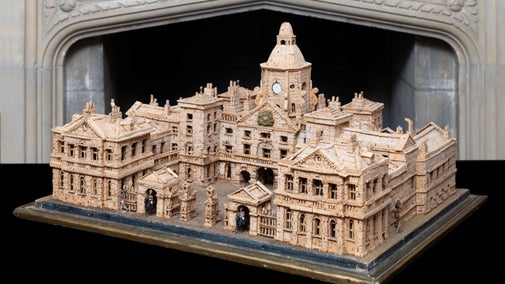
Springhill's collections
Explore the objects and works of art we care for at Springhill on the National Trust Collections website.

Part of the collection of historic dress and textiles at Springhill House, this magnificent silk gown, or ‘mantua’, was made for attendance at court in the 1740s. A hundred years later, the dress made another royal appearance, at Queen Victoria’s 18th-century costume ball at Buckingham Palace.
This court mantua was created for Lady Ann Bligh, probably shortly after her marriage in November 1748 to Bernard Ward of Castle Ward, County Down. The gown conforms to a very particular style, which would only ever be worn at events in the regular court calendar, when the Wards were in London.
In its original form, the skirt, or ‘petticoat,’ would have been worn over a wide, narrow hoop, extending almost three feet on either side of the waist. Moving with stately elegance in such a dress was a considerable challenge, especially as, having greeted the monarch, one was expected to walk backwards when leaving the royal presence.
It is possible that Lady Ann ordered the mantua for attending the King’s birthday. Gold brocaded silks were de rigueur for this annual event in November, one of the most important court celebrations of the year.
The broad sweep of the original petticoat showed the pattern of the fabric to its best advantage. Hand-woven in Spitalfields, London - a hub of 18th-century textile manufacture - it was probably specially commissioned for Lady Ann’s dress. The mantua-maker took particular care with the placement of the floral motifs when sewing the back of the bodice, making the most of the design.
Scattered with golden wheatsheaves, blue flax flowers and poppies with gold buds, the brocaded silk reflects the British passion for botanical design. But this bountiful harvest may also have conveyed a political message, suggesting the prosperity and wellbeing of the nation under the rule of its landed classes.
Lady Ann’s court mantua was passed down through generations of her descendants, the family of the Earls of Clanwilliam. The almost perfect preservation of the silk, entirely unfaded, suggests it spent most of its life safely stored in a chest. But it was to have one last, glorious outing.

On a summer evening in 1845, Queen Victoria hosted one of the greatest social events of the year - a costume ball at Buckingham Palace. Themed around the period 1740-50, the ball was intended to boost the British textile industry, so Victoria and Prince Albert had their costumes specially made. However, most of the guests rather defeated the purpose, simply raiding their attics for their ancestors’ clothing.
Lady Clanwilliam lent the court mantua to her sister, Lady Mary Herbert, Countess Bruce, for the occasion. Despite dating to the exact period of the costume ball, it was substantially altered to conform both to the fashionable body shape of the mid-19th century and to what people of the time thought 18th-century garments should look like - something more akin to French aristocratic clothing of the 1770s-80s.
Lady Mary’s modifications resulted in a more sinuous, small-waisted shape, with shorter, figure-hugging sleeves and a softer neckline. The enormous expanse of the petticoat was gathered in to form a bell-shaped skirt, which was probably open at the front and draped in flounces over a specially made, highly decorative underskirt.
The mantua had become a highly feminine confection - which was also much easier to dance in. With Viscount Sidney as her partner, Countess Bruce danced in the royal set for the Queen’s third minuet of the evening.
Today, the court mantua is in a hybrid state: most of the Victorian modifications have been reversed, except for the petticoat, which is still more redolent of the 1840s. This will give National Trust historic dress specialists and conservators much food for thought as they continue to care for this important item in the Springhill House collection. One thing is certain - there is a long life ahead for Lady Ann Bligh’s spectacular gown.


Explore the objects and works of art we care for at Springhill on the National Trust Collections website.
Step back in history on a visit to Springhill, often referred to as 'one of the prettiest houses in Ulster'.

Discover historical stories at Springhill. Learn about the colourful history of the walled garden and the story of Mina Lowry Lenox Conyngham, a previous resident of the house.

The art and heritage collections we care for rival the world’s greatest museums. Learn more about the collection of paintings, decorative art, costume, books, household and other objects at historic places.

See the breadth of our collection of works of art, furniture and more: we care for around a million objects at over 200 historic places, there’s a surprise discovery around every corner.

Discover the stories behind some of the greatest artworks and artefacts looked after by the National Trust, as told in a dedicated book, 125 Treasures from the Collections of the National Trust.
